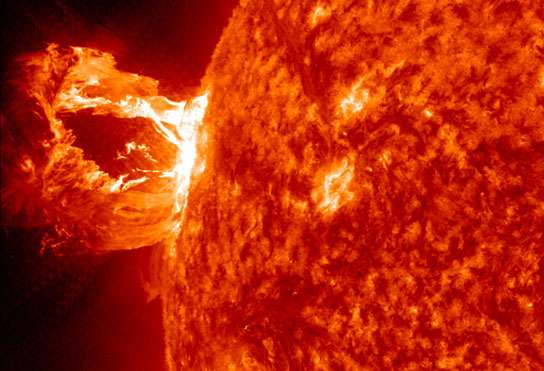Researchers correlate rheumatoid arthritis and giant cell arteritis with solar cycles

What began as a chat between husband and wife has evolved into an intriguing scientific discovery. The results, published in May in BMJ (formerly British Medical Journal) Open, show a "highly significant" correlation between periodic solar storms and incidences of rheumatoid arthritis (RA) and giant cell arteritis (GCA), two potentially debilitating autoimmune diseases. The findings by a rare collaboration of physicists and medical researchers suggest a relationship between the solar outbursts and the incidence of these diseases that could lead to preventive measures if a causal link can be established.
RA and GCA are autoimmune conditions in which the body mistakenly attacks its own organs and tissues. RA inflames and swells joints and can cause crippling damage if left untreated. In GCA, the autoimmune disease results in inflammation of the wall of arteries, leading to headaches, jaw pain, vision problems and even blindness in severe cases.
Inspiring this study were conversations between Simon Wing, a Johns Hopkins University physicist and first author of the paper, and his wife, Lisa Rider, deputy unit chief of the Environmental Autoimmunity Group at the National Institute of Environmental Health Sciences in the National Institutes of Health, and a coauthor. Rider spotted data from the Mayo Clinic in Rochester, Minnesota, showing that cases of RA and GCA followed close to 10-year cycles. "That got me curious," Wing recalled. "Only a few things in nature have a periodicity of about 10-11 years and the solar cycle is one of them."
"More than a coincidental connection"
Wing teamed with physicist Jay Johnson of the U.S. Department of Energy's Princeton Plasma Physics Laboratory, a long-time collaborator, to investigate further. When the physicists tracked the incidence of RA and GCA cases compiled by Mayo Clinic researchers, the results suggested "more than a coincidental connection," said Eric Matteson, chair of the division of rheumatology at the Mayo Clinic, and a coauthor. This work drew upon previous space physics research supported by the DOE Office of Science.
The findings found increased incidents of RA and GCA to be in periodic concert with the cycle of magnetic activity of the sun. During the solar cycle, dramatic changes that can affect space weather near Earth take place in the sun. At the solar maximum, for example, an increased number of outbursts called coronal mass ejections hurl millions of tons of magnetic and electrically charged plasma gas against the Earth's magnetosphere, the magnetic field that surrounds the planet. This contact whips up geomagnetic disturbances that can disrupt cell phone service, damage satellites and knock out power grids. More importantly, during the declining phase of the solar maximum high-speed streams develop in the solar wind that is made up of plasma that flows from the sun. These streams continuously buffet Earth's magnetosphere, producing enhanced geomagnetic activity at high Earth latitudes.
The research, which tracked correlations of the diseases with both geomagnetic activity and extreme ultraviolet (EUV) solar radiation, focused on cases recorded in Olmsted County, Minnesota, the home of the Mayo Clinic, over more than five decades. The physicists compared the data with indices of EUV radiation for the years 1950 through 2007 and indices of geomagnetic activity from 1966 through 2007. Included were all 207 cases of GCA and all 1,179 cases of RA occurring in Olmsted County during the periods and collected in a long-term study led by Sherine Gabriel, then of the Mayo Clinic and now dean of the Rutgers Robert Wood Johnson Medical School.
Correlations proved to be strongest between the diseases and geomagnetic activity. GCA incidence—defined as the number of new cases per capita per year in the county—regularly peaked within one year of the most intense geomagnetic activity, while RA incidence fell to a minimum within one year of the least intense activity. Correlations with the EUV indices were seen to be less robust and showed a significantly longer response time.
Consistent with previous studies
The findings were consistent with previous studies of the geographic distribution of RA cases in the United States. Such research found a greater incidence of the disease in sections of the country that are more likely to be affected by geomagnetic activity. For example, the heaviest incidence lay along geographic latitudes on the East Coast that were below those on the West Coast. This asymmetry may reflect the fact that high geomagnetic latitudes—areas most subject to geomagnetic activity—swing lower on the East Coast than on the opposite side of the country. While Washington, D.C., lies just 1 degree farther north than San Francisco geographically, for example, the U.S. capital is 7 degrees farther north in terms of geomagnetic latitude.
Although the authors make no claim to a causal explanation for their findings, they identify five characteristics of the disease occurrence that are not obviously explained by any of the currently leading hypotheses. These include the east-west asymmetries of the RA and GCA outbreaks and the periodicities of the incidences in concert with the solar cycle. Among the possible causal pathways the authors consider are reduced production of the hormone melatonin, an anti-inflammatory mediator with immune-enhancing effects, and increased formation of free radicals in susceptible individuals. A study of 142 electrical power workers found that excretion of melatonin—a proxy used to estimate production of the hormone—was reduced by 21 percent on days with increased geomagnetic activity.
Confirming a causal link between outbreaks of RA and GCA and geomagnetic activity would be an important step towards developing strategies for mitigating the impact of the activity on susceptible individuals. These strategies could include relocating to lower latitudes and developing methods to counteract direct causal agents that may be controlled by geomagnetic activity. For now, say the authors, their findings warrant further investigations covering longer time periods, additional locations and other autoimmune diseases.



















